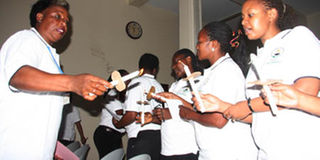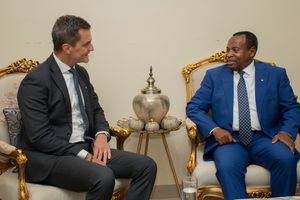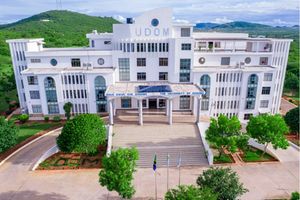Muhimbili’s promising future

Students of the Muhimbili Orthopaedic Institute light candles during a past function. The Institute is currently constructing a seven-storey building popularly known as Moi Phase Three which will help reduce the transfer of patients outside the country. PHOTO|FILE
What you need to know:
The-seven-storey building popularly known as Moi Phase Three will help reduce the transfer of patients outside the country which are fuelled by lack of medical facilities in the hospital including scarcity of equipment, according to the deputy minister for Health and Social Welfare, Dr Seif Rashid.
Dar es Salaam. Tanzania may soon enjoy better medical services at Muhimbili Orthopedic Institute (MOI), when the new building under construction is completed. For a long time many patients have been encountering difficulties when accessing services. Others opt to seek such services overseas as they are forced to dig deeper in their pockets.
The-seven-storey building popularly known as Moi Phase Three will help reduce the transfer of patients outside the country which are fuelled by lack of medical facilities in the hospital including scarcity of equipment, according to the deputy minister for Health and Social Welfare, Dr Seif Rashid.
Referrals are costing the government a lot, especially in a country which is still making steps towards sustainable development.
The MOI executive director, Prof Lawrence Museru, says upon completion of the building at the end of this year, the institute would be able to purchase medical equipment such as Magnetic Resonance Imaging (MRI) and Computerized Tomography which are said to be scarce in the country.
The MOI boss says cyberknife digital angiography (CDA) which is nowhere in the country, will also be available at the institute in a bid to increase service delivery. This project, according to him, will see an increase of 20 beds for patients in critical condition up from eight which are now available at the hospital.
The high dependence ward which is currently missing will also be created and will have 24 beds. Again, there will be a special cost-sharing ward which will have a total of 240 beds as well as 62 for patients who will be paying for services. This will enable the institute to have a total of 380 beds up from the current 159.
Even as the construction of a new facility is still ongoing, Prof Museru is optimistic that the rooms used for surgery at MOI are the best compared to those in other hospitals in Tanzania and even in East and Central Africa.
The rooms which he says have Lamina Flow, the best air system, help a patient who is undergoing surgery to be free from any diseases while they are being attended to by a specialist. For many years, the institute has been providing medical services to patients who flock thehospital seeking treatment.
Currently, concerns have been raised on how to control motorcyclists who have been thronging the institute due to the fact that accidents involving them have escalated, leaving many youth without limbs.
A cross check by The Citizen at the institute established that many patients who came for treatment were victims of accidents mainly caused by motorbikes (BodaBoda) riders and tricycle (Bajaj) drivers.
Despite the ongoing construction of a new building, the institute is facing a number of challenges which need a direct intervention from the government. According to Prof Museru, financial constraints have continued to halt some operations.
“The budget which is allocated to MOI in each financial year cannot be enough to cater for medical services because the number of patients has kept on increasing’’, he adds.
But when opening training to medical experts from different countries which took place at MOI recently, the deputy minister for Health and Social Welfare, Dr Seif Rashid, said the government would continue supporting the institute in tandem with concerted efforts to increase service delivery. He also expressed optimism on the ongoing construction of the new building, saying it would help reduce congestion.
However, the institute has acute shortage of specialists especially in spinal cord related diseases, nerves and brain ailments. Specialists at MOI say the current doctors at the institute are few compared to the number of patients who seek such treatment.
The Citizen learned that the institute currently has five specialists namely: Prof Joseph Kahamba, Dr Khamis Shaban, Dr Othman Wanini, Dr Nicephorous Rutabasibwa,Dr Clement Mugisha, and Dr Abednego Kinasha who is a retiree.
All patients suffering from such diseases are forced to travel all the way from different regions to Muhimbili. Others, especially the poor, succumb to death because they cannot afford the cost of commuting to Dar es Salaam from up country to seek treatment.
In a bid to reduce the shortage of experts, MOI in collaboration with Muhimbili University of Health and Allied Sciences (Muhas) introduced a Master’s programme to produce enough experts in orthopedic surgery. According to Prof Museru, some of these experts have already graduated and have been posted in different regions to curb the shortage. Others are still pursuing studies.
On measures to have neuro surgeon specialists, through the ministry of Health and Social Welfare, Prof Museru has been sending doctors outside the country to acquire more skills that will help the institute in curbing brain related diseases. As of now, one doctor is in Egypt pursing studies on the same subject.
An increase in the number of patients visiting the institute is another thorn in the flesh, according to him. The statistics at Moi seen by this paper indicate that between 1996-997 more than 5,000 patients were admitted per year, while the number of those seeking outpatient services was at 6,700.
The number has kept on growing whereby in 2011/2012 more than 7,070 were admitted. The number is equal to an increment of 2,070 patients (41.4 per cent). Again those seeking outpatient services have steadily increased to 62,800 recording an increment of 56,100 (837.3 per cent).




